Abd ar-Rahman II
Abd ar-Rahman II (Arabic: عبد الرحمن الأوسط) (792–852) was the fourth Umayyad Emir of Córdoba in al-Andalus from 822 until his death.[1] A vigorous and effective frontier warrior, he was also well known as a patron of the arts.
| Abd ar-Rahman al-Awsat عبد الرحمن الأوسط | |
|---|---|
 Silver dirham coined during the reign of Abd ar-Rahman II. | |
| 4th Emir of Córdoba | |
| Reign | 21 May 822–852 |
| Predecessor | al-Hakam I |
| Successor | Muhammad I |
| Born | 792 Toledo |
| Died | 852 (aged 59–60) Córdoba |
| Dynasty | Umayyad dynasty |
| Father | al-Hakam I |
| Mother | Halawah |
Abd ar-Rahman was born in Toledo, the son of Emir al-Hakam I. In his youth he took part in the so-called "massacre of the ditch", when 72 nobles and hundreds of their attendants were massacred at a banquet by order of al-Hakam.
He succeeded his father as Emir of Córdoba in 822 and for 20 years engaged in nearly continuous warfare against Alfonso II of Asturias, whose southward advance he halted. In 825, he had a new city, Murcia, built, and proceeded to settle it with Arab loyalists to ensure stability. In 835, he confronted rebellious citizens of Mérida by having a large internal fortress built. In 837, he suppressed a revolt of Christians and Jews in Toledo with similar measures.[2] He issued a decree by which the Christians were forbidden to seek martyrdom, and he had a Christian synod held to forbid martyrdom.
In 839 or 840, he sent an embassy under al-Ghazal to Constantinople to sign a pact with the Byzantine Empire against the Abbasids.[3] Another embassy that was sent an may have either went to Ireland or Denmark, likely encouraging trade in fur and slaves.[4]
In 844, Abd ar-Rahman repulsed an assault by Vikings who had disembarked in Cádiz, conquered Seville (with the exception of its citadel) and attacked Córdoba itself. Where Abderrahman || defeated the Vikings by letting them into the city and surrounded with best of his army to slaughter them to the end. Thereafter he constructed a fleet and naval arsenal at Seville to repel future raids.
He responded to William of Septimania's requests of assistance in his struggle against Charles the Bald who had claimed lands William considered to be his.[5]

Abd ar-Rahman was famous for his public building program in Córdoba. He made additions to the Mosque–Cathedral of Córdoba.[1] A vigorous and effective frontier warrior, he was also well known as a patron of the arts.[6] He was also involved in the execution of the "Martyrs of Córdoba",[7] and was a patron of the great composer Ziryab. He died in 852 in Córdoba
References
- "'Abd ar-Rahman II". Encyclopædia Britannica. Vol. I: A-Ak - Bayes (15th ed.). Chicago, IL: Encyclopædia Britannica, Inc. 2010. pp. 17. ISBN 978-1-59339-837-8.
- The Inheritance of Rome, Chris Wickham, Penguin Books Ltd. 2009, ISBN 978-0-670-02098-0. p. 341.
- Huici Miranda, Ambrosio (1965). "al-Ghazāl". In Lewis, B.; Pellat, Ch. & Schacht, J. (eds.). Encyclopaedia of Islam. Volume II: C–G (2nd ed.). Leiden: E. J. Brill. p. 1038. OCLC 495469475.
- Graham-Campbell, James (2013). The Viking World. Frances Lincoln Limited Publishers. p. 31.
- El-Hajji, Abderrahman. ""Andalusian Diplomatic Relations with the Franks during the Umayyad period"". Islamic Studies. 6: 27–28.
- Thorne, John (1984). Chambers biographical dictionary. Edinburgh: Chambers. ISBN 0-550-18022-2.
- Chisholm, Hugh, ed. (1911). . Encyclopædia Britannica. Vol. 1 (11th ed.). Cambridge University Press. p. 31.
